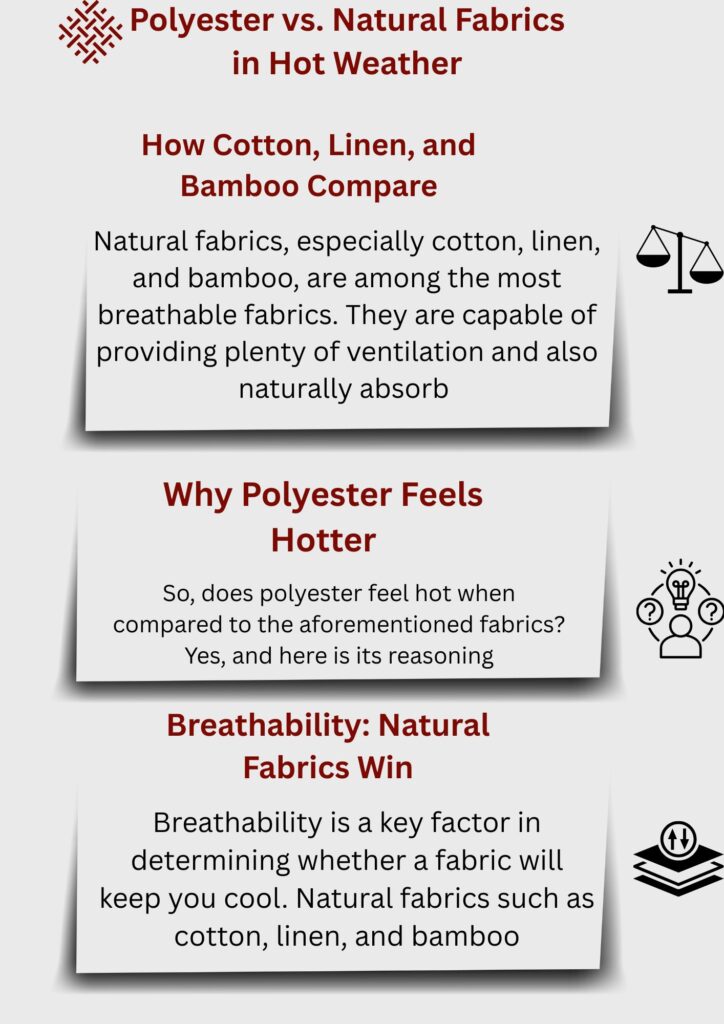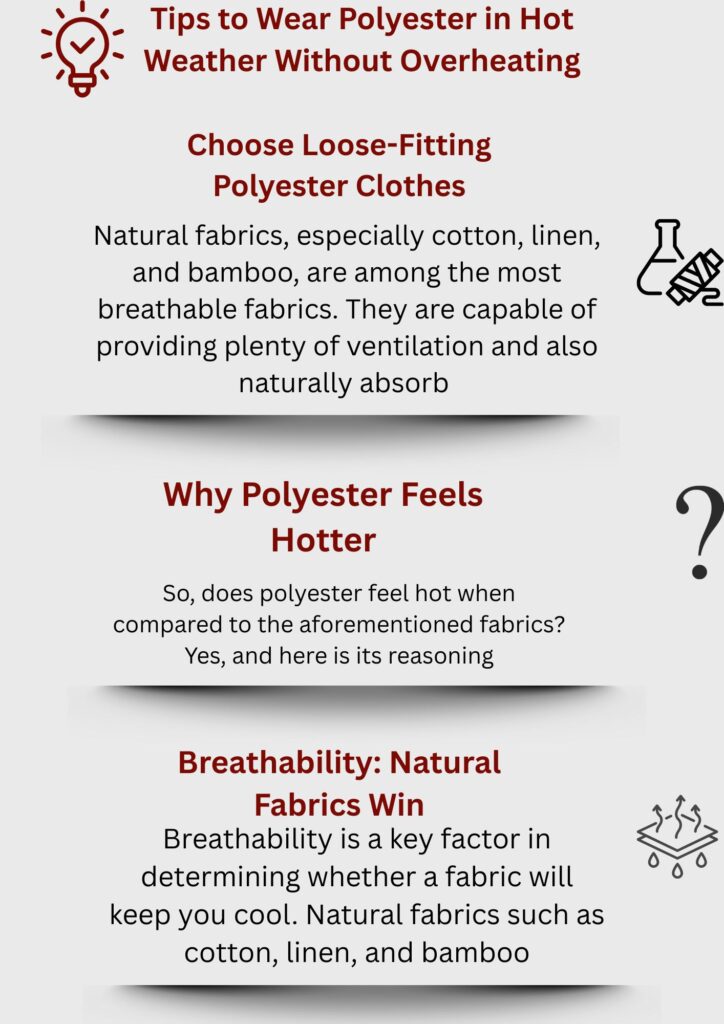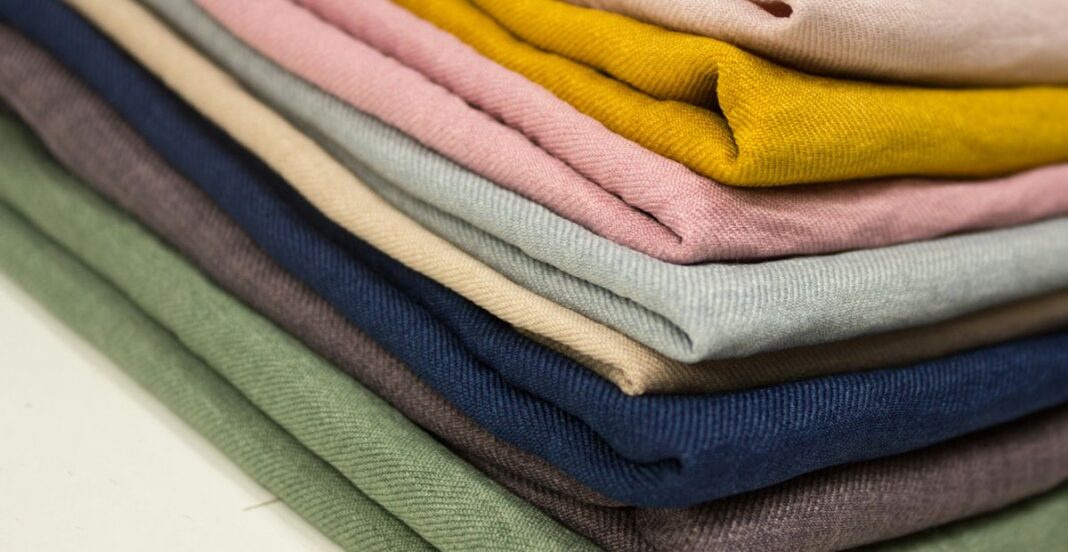Introduction
The synthetic fabric polyester is a common fabric manufactured from fibers of crude oil. It does not come from a natural source like cotton or linen. Rather, polyester originates from a synthetic method, a process that is alchemic in nature. Due to its sheer strength and low price, polyester is commonly utilized in clothing, sportswear, furniture, engineering textiles, and even bedding.
Despite its widespread use, a common concern revolves around one question: Is wearing polyester hot or cold? Most people, especially those living in hot regions, are likely to overheat or feel sticky in polyester clothing. Most of the concerns focus around the breathability, the heat retention capability, and the circulation of air in and around the fabric.
This article examines the experiences and a bit of science behind the polyester story along with natural fabrics comparisons, dispelling common myths, and actionable steps on staying cool in polyester.
How Does Polyester Affect Body Temperature?
Heat Retention: Why Polyester Retains more heat
Due to tight woven polyester and synthetic materials, the fabric is less porous. Unlike natural fabrics, polyester is not as breathable. Thus its dense weave permits heat to accumulate in the layer of fabric, so your body is likely to struggle in excess heat.
Retention of heat become uncomfortable in humid conditions or under the sun. With respect to air permeability, cotton performs better than polyester. Thus, polyester acts as an insulating barrier during hot weather and direct sunlight.
Moisture-Wicking: A Double-Edged Sword
Sweat and polyester fabrics have an inseparable bond. While the polyester pushes moisture away from the skin to the outer layer of the garment, it helps keep warm. Though, there are some disadvantages.
Unlike cotton, polyester does not absorb moisture, leading to sweats and clammy sensations. This feeling of clamminess, especially in non-ventilated or non-layered polyestr garments, worsens feeling hotter.
Insulation Properties: Good for Cold Weather
Polyster has great insulation for cold weather, making it a beloved material for winter clothing. Coats and sweats keep the heat close to the body and are ideal in cold weather. However, in summer, it becomes an advantage.
On hot days, wearing polyester traps heat. Due to the lack of ventilation, the body is not able to cool down, resulting in discomfort and sweating.
Polyester vs. Natural Fabrics in Hot Weather

How Cotton, Linen, and Bamboo Compare
Natural fabrics, especially cotton, linen, and bamboo, are among the most breathable fabrics. They are capable of providing plenty of ventilation and also naturally absorb moisture. To illustrate, when wearing cotton, sweat is absorbed and evaporated, resulting in a cooling effect.
Linen is also breathable, but increases the lightness of its texture, thus its idealness for hot regions. Bamboo is soft and moisture absorbent and is also antimicrobial, adding sustainable comfort.
Why Polyester Feels Hotter
So, does polyester feel hot when compared to the aforementioned fabrics? Yes, and here is its reasoning: polyester’s tight weave along with its synthetic nature, make moisture and heat accumulation a certainty. Without any form of ventilation, heaters become hotter at a faster rate. Polyester becomes hotter in the sun as well, thus enhancing the disparity in warmth.
Because of these factors, polyester is one of the most uncomfortable fabrics to wear during the summer. This is even more true when compared to natural fabrics, which are breathable and less hot.
When Is Polyester a Good Choice?
Perfect for Activewear and Workout Clothes
Polyester’s heat retention is a drawback, particularly when it comes to activewear. However, it is a reliable fabric for exercise clothing due to durability, moisture-wicking, and athletic performance. If engineered properly, polyester fabrics can keep moisture away from the body and allow movement for higher level activities.
In addition, modern polyester fabrics for sports apparel have mesh panels and ventilation zones. These features help to improve the airflow and decrease the “sticky” feeling usually associated with polyester fabrics.
Great for Layering in Cold Weather
During colder seasons, polyester provides an excellent insulating layer. It retains heat while blocking moisture, making it a suitable material for baselayers, jackets, and outdoor clothing. This is why you often find fleece, thermal leggings and ski wear made from polyester.
Its heat retention ability can help protect the body against the extreme cold, particularly when worn beneath waterproof layers.
Polyester and Cotton or Bamboo blends
Polyester’s strength, moisture control, and durability makes it a suitable fabric for sportswear, casual wear, uniforms, and even bedsheets. Many manufacturers use it with cotton or bamboo to improve breathability, which adds comfort and makes it far less likely to overheat.
Ways to Wear Polyester in Hot Weather Without Overheating
Tips to Wear Polyester in Hot Weather Without Overheating

Choose Loose-Fitting Polyester Clothes
Tighter-fitting polyester clothing is likely to be hotter due to constriction. Loose-fit garments allow better air circulation and temperature control. Loose-fitting clothing minimizes contact with skin and reduces the sticky sensation associated with polyester.
Opt for Mesh and Ventilated Designs
For the very purpose mentioned, polyester sportswear is often outfitted with mesh panels. These panels enable the release of heat and the circulation of air. Especially during physical exercise or outdoor activities, wearing ventilated designs can significantly improve comfort.
Wear Light-Colored Polyester
Darker colors absorb more heat and light. Light-colored polyester fabrics will reflect sunlight and keep your body cooler. Light, beige or pastel shades are suitable polyester colors for hot days.
Look for Moisture Wicking & UV Protective
Polyester blends nowadays tend to offer woven UV protective fabrics and moisture-wicking polyester. These features are very useful in outdoor clothing, especially to mitigate the chances of sunburn and to keep you dry. Always check the label or description for the listed features.
Common Myths About Polyester and Heat
Myth 1: “All Polyester Is Bad for Summer”
Not all polyester fabrics are equal. Some are designed for warmer climates, like the polyester made for high-performance fabrics. Innovations like CoolMax or Nike’s Dri-FIT offer superior evaporation and moisture control. These fabrics are effective even in scorching heat.
Myth 2: “Sweat and Heat Increase Thrombi Polyesters Drape Often”
It’s not polyester alone; it is the way the fabric is woven and blended with other materials. Mesh tops or even relaxed shirt styles can counter overheating. While pure polyester may increase the sweating, blended or ventilated polyester can alleviate the overheating.
Best Alternatives to Polyester for Hot Weather
Cotton: Soft and Breathable
Withstand the test of time, cotton is still a prominent choice in the hot weather. It is absorbent and soft against the skin. During hot and humid weather, it may get damp. But, it is one of the materials that can effectively dry and provide cooling.
Linen: The Ultimate Summer Fabric
One of the coolest fabric that you can wear the ultimate hot weather. It is very lightweight with maximum airflow that can offer superior breathability. It wrinkles easily but still one of the coolest fabrics you can wear.
Bamboo and Tencel: Eco-Friendly and Cool
Bamboo textiles exhibit both antibacterial properties and breathability. Tencel, produced from eucalyptus pulp, demonstrates superior moisture management and softness. Both bamboo and Tencel are eco-conscious and superb options when looking to stay cool.
Performance Fabrics: Engineered for Heat
CoolMax, Under Armour, and Dri-FIT are known for their advanced synthetic fabrics. These fabrics are designed for performance in extreme heat. They regulate temperature, wick moisture, and dry quickly, making them ideal for athletes and those who engage in outdoor activities.
Conclusion
The response to whether polyester is hot to wear is yes and no at the same time. Older versions of polyester did not allow for breathability and would effectively trap heat. These days, advancements in textile technology have been nothing short of remarkable. Your textile of choice, the design, and the climate in question will determine whether polyester works for you.
In the case of high heat conditions, natural fabrics like cotton or linen are far superior to polyester. This, however, is not the case with cold layering, athletic wear, or high-performance blends, in all of which polyester excels.
It is indeed possible to wear polyester comfortably and without the risk of overheating by carefully selecting the appropriate fabric blend, fit, and color. The most important thing is to know the mechanics of the fabric and plan your outfit around it.


